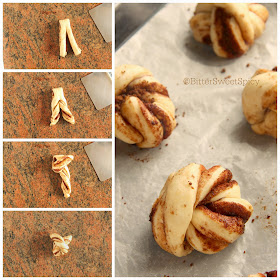I've made cinnamon buns many times but they were always the regular buns in which the filled dough is rolled, sliced & baked in a deep baking pan like these. This time, I wanted to try something different, so I did the Swedish way of forming their buns. They are definitely more attractive than the regular buns. Compared to the regular rolls, most part of each Swedish bun is exposed to the direct oven heat. As a result, the bun has more crusty surface & less white, soft & fluffy part. So if you prefer softer & fluffier buns, then the regular rolls would be a better choice.
Here, I used the Kopitiam Milk Bun dough recipe shared by Sonia. This recipe uses quite a bit of full cream milk, so I'm not surprised the buns turned out very flavourful. Besides, it also uses the overnight-dough method, that too adds on to the flavour. Since the buns already taste so good, I ate mind without any frosting. But if you still want your cinnamon buns with cream cheese frosting just like my cinnamon-bun monsters, please refer to my other cinnamon bun posts for the recipe.
I apologise for spamming this post with so many photos. I just love looking at the buns. Besides, I took so many pictures & many of them turned out well. So hope they are enough to motivate you, especially the cinnamon-bun monsters out there, to bake them!
OVERNIGHT SPONGE DOUGH
215g high protein flour
125g full cream milk (cold) - I used 135g.
2g instant yeast (1/2 tsp)
125g full cream milk (cold) - I used 135g.
2g instant yeast (1/2 tsp)
Mix all ingredients in a bowl till a rough dough is formed. Cover the bowl with cling wrap and store in the fridge overnight.
BASIC DOUGH
1 quantity of above overnight sponge dough
90g high protein flour
90g high protein flour
12g milk powder (Sonia didn't use.)
30g egg (1/2 large egg)
4g instant yeast (1tsp)
3g fine salt (1/2 tsp)
60g sugar
45g butter (room temperature) - I used only 30g.
1tbsp milk (cold)
Method:
FILLING
butter, softened
cinnamon powder
brown sugar
1 egg - lightly beaten (for egg wash)
TO ASSEMBLE THE CINNAMON BUNS:
30g egg (1/2 large egg)
4g instant yeast (1tsp)
3g fine salt (1/2 tsp)
60g sugar
45g butter (room temperature) - I used only 30g.
1tbsp milk (cold)
Method:
- Tear the overnight sponge dough into pieces into a mixing bowl. Add in the rest of ingredients, except butter, & knead till a smooth dough is formed.
- Add in butter and knead until dough is smooth, shiny and elastic. (I mixed mine using the electric mixer [dough hook] for about 10 minutes in all.)
- Cover the bowl with cling film and set aside to proof till double in size for 45-60 minutes. (I poured the dough onto a floured working surface & mould it into a smooth round. Then I covered it with the unwashed bowl that I used for mixing.)
FILLING
butter, softened
cinnamon powder
brown sugar
1 egg - lightly beaten (for egg wash)
TO ASSEMBLE THE CINNAMON BUNS:
- Place the proofed dough onto a floured working surface. Deflate it by punching it down & then shaping the dough into a smooth ball. Leave to rest for 15 minutes.
- Roll the dough out into a large rectangle. You want the long sides over twice as long as the short sides. Spread butter over the entire rectangle. Then sprinkle cinnamon powder followed by dark brown sugar.
- Fold it into thirds lengthwise. It should measure about 16x8 inch. At this point, you may want to roll out the dough to flatten it a little bit. Cut the roll widthwise with a sharp knife into 8-10 slices.
- Take a slice of dough & cut it into two almost all the way. Twist the ends of each slice in opposite directions a few times. Lift up the twists in a crisscross manner. Tuck the ends under & seal with a little water if needed. Place the slices onto a baking sheet which has been lined with silicone paper. Cover and let rise for about 30 minutes.
- Preheat the oven to 190 deg C. Brush the proofed buns with the beaten egg. This will give the buns a beautiful golden colour when baked. Bake for about 15-20 minutes or until golden brown. Place the baked rolls on a cooling rack. Serve warm.
Note:
- I made the buns twice (& each time 2 recipes!) within a week. The first time, a recipe produced 8 big pieces as seen in my pictures above. Yesterday, I made 10 buns for each recipe. I like the smaller pieces better.
- Please refer to the following pictures & video to better understand the assembly process. The pictures below are taken yesterday when I made 10 buns with 1 recipe.




























